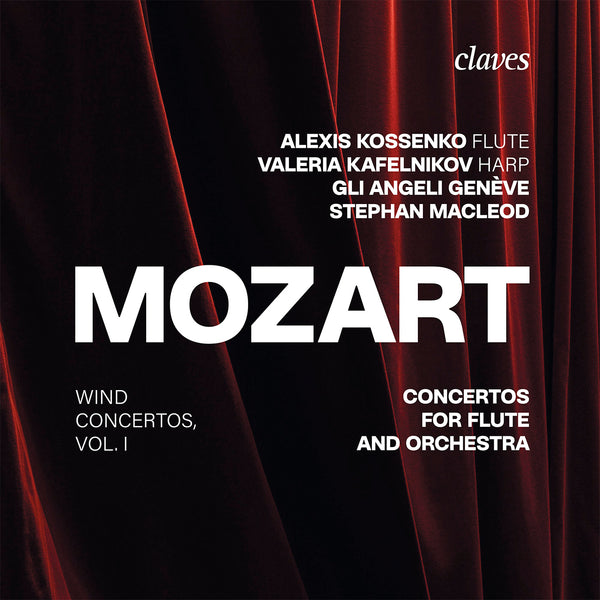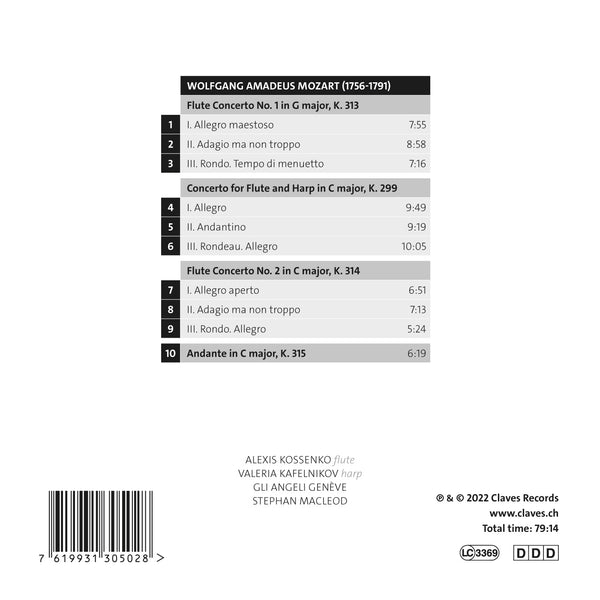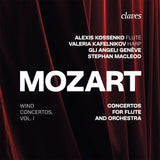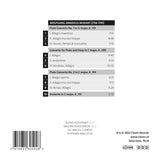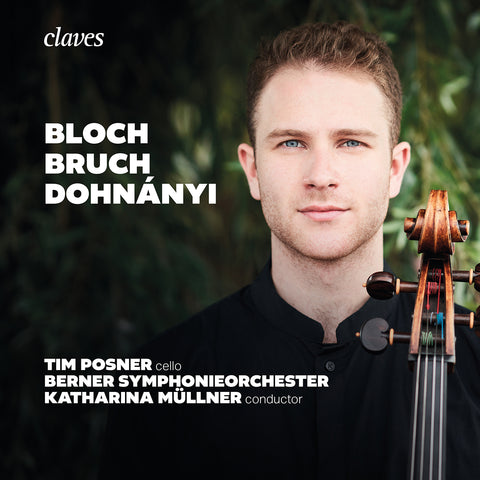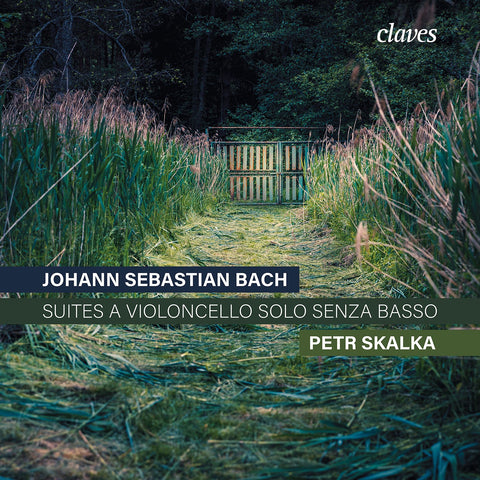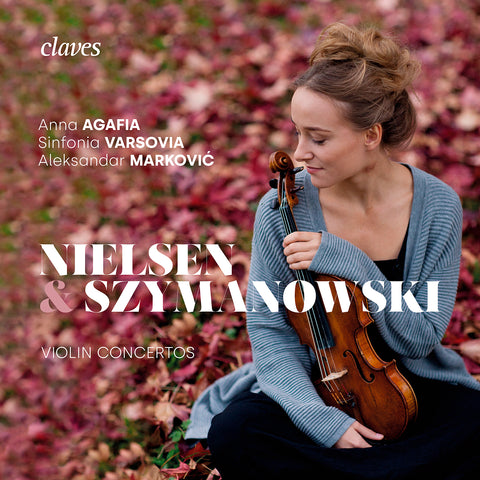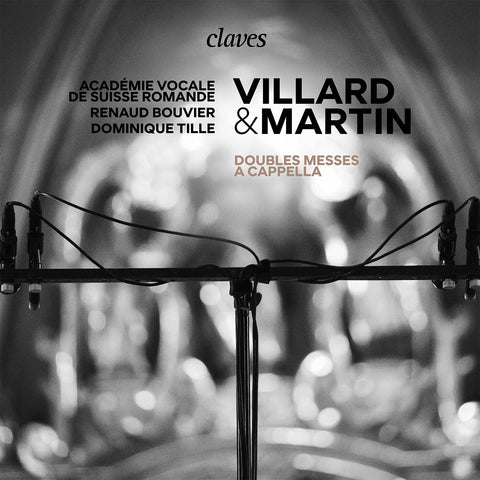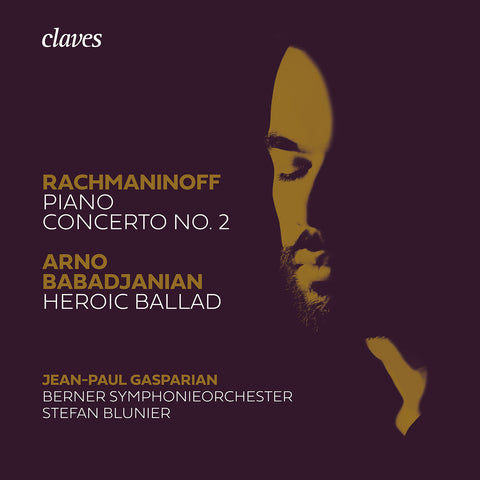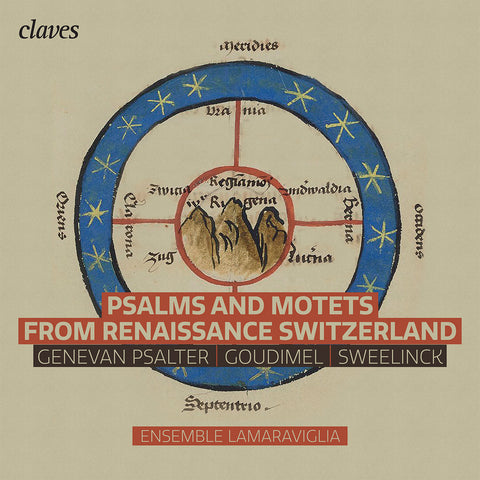(2022) Mozart: Concertos for flute and orchestra
Kategorie(n): Concerto Orchester Repertoire
Instrument(e): Fagott Violoncello Kontrabass Flöte Harfe Oboe Geige
Gesangsstimme(n): Alt
Hauptkomponist: Wolfgang Amadeus Mozart
Ensemble: Gli Angeli Genève
Dirigent: Stephan MacLeod
CD-Set: 1
Katalog Nr.:
CD 3050
Freigabe: 07.10.2022
EAN/UPC: 7619931305028
Dieses Album ist jetzt neu aufgelegt worden. Bestellen Sie es jetzt zum Sonderpreis vor.
CHF 18.50
Dieses Album ist nicht mehr auf CD erhältlich.
Dieses Album ist noch nicht veröffentlicht worden. Bestellen Sie es jetzt vor.
CHF 18.50
Dieses Album ist nicht mehr auf CD erhältlich.
CHF 18.50
Inklusive MwSt. für die Schweiz und die EU
Kostenloser Versand
Dieses Album ist nicht mehr auf CD erhältlich.
Inklusive MwSt. für die Schweiz und die EU
Kostenloser Versand
Dieses Album ist jetzt neu aufgelegt worden. Bestellen Sie es jetzt zum Sonderpreis vor.
CHF 18.50
Dieses Album ist nicht mehr auf CD erhältlich.
This album has not been released yet.
Pre-order it at a special price now.
CHF 18.50
Dieses Album ist nicht mehr auf CD erhältlich.
CHF 18.50
Dieses Album ist nicht mehr auf CD erhältlich.
SPOTIFY
(Verbinden Sie sich mit Ihrem Konto und aktualisieren die Seite, um das komplette Album zu hören)
MOZART: CONCERTOS FOR FLUTE AND ORCHESTRA
ZAUBERFLÖTE
Wenn Mozart dem Konzert seiner Zeit seine endgültige Form gab, dann deshalb, weil er ihm alle Merkmale der Opernarie übertrug, indem er dem Cantabile – das er in seiner Korrespondenz oft erwähnt – die größte Bedeutung beimaß und die vokalen virtuosen Läufe in instrumentale Figurationen verwandelte. Der Solist ist eine Figur, deren Rhetorik dem in der Einleitung vorgestellten Orchestermaterial eine tiefere, intimere und sensiblere Dimension verleiht. Dies ist der Grund für die Beziehung zwischen dem Einzelnen und der Gruppe, zwischen den Soli und den Tutti.
Mozart hatte immer den Musiker im Sinn, für den das Werk geschrieben wurde, sei es eine Arie oder ein Konzert. Er schneiderte dann einen maßgeschneiderten Anzug, wie er sagte (in seinen Klavierkonzerten bezog er sich auf sich selbst, daher die Tiefe und Komplexität dessen, was in diesen Werken zum Ausdruck kommt). Für einen Solisten mit virtuoser Technik komponierte er höchst anspruchsvolle Passagen; für jemanden, der weniger sicher war, lieferte er eine zugänglichere Partitur. Daher ist das letzte der vier Hornkonzerte, die für den berühmten Joseph Leutgeb geschrieben wurden, weit weniger anspruchsvoll als die vorherigen, da der alternde Solist die höchsten Töne nicht mehr spielen konnte. Ebenso verwendet der Flötenpart des Flöten- und Harfenkonzerts die tiefen Töne, die die Einzigartigkeit des Instruments des Grafen von Guînes ausmachten, der das Stück in Auftrag gab (die Töne Des und C, die heute auf modernen Flöten zu finden sind).
Die Überlegenheit von Mozarts Konzerten gegenüber denen seiner Zeitgenossen, einschließlich Haydn, liegt in der subtilen Kombination der Starrheit der Form und der Dramatisierung des musikalischen Diskurses. Mozart hatte bereits in den Arien der opera seria damit experimentiert und es geschafft, Spannungen und Entwicklungen innerhalb einer statischen Form zu erzeugen. Daher versuchte er nicht, eine formale Neuerung zu schaffen: Seine Konzerte sind größtenteils nach dem gleichen Muster aufgebaut. Ihr Inhalt ist jedoch sehr reichhaltig, und dieser Reichtum wächst mit seiner Entwicklung. Er beruht größtenteils auf dem melodischen Genie des Komponisten, das es ihm ermöglichte, mehrere charakteristische Ideen in einer organischen Kontinuität zu verbinden, als ob jede einzelne aus der vorherigen hervorginge. Dies ist auch darauf zurückzuführen, dass das Orchester den Solisten nicht nur begleitet, sondern sich voll und ganz an der Gestaltung des musikalischen Diskurses beteiligt. [..]
DIE SUCHE NACH UNABHÄNGIGKEIT
Mozarts Konzerte zu spielen, stellt einen Flötisten vor dasselbe Problem wie Bachs Sonaten und Partiten einen Geiger oder seine Suiten einen Cellisten. Dieses Problem tritt bei Meisterwerken auf, die zu früh in unser Repertoire aufgenommen wurden; wenn wir mit dem Bewundernswerten vor dem Gewöhnlichen konfrontiert werden oder wenn uns die Ausnahme vor der Regel gelehrt wird. Wie können wir die Distanz finden, die es uns ermöglicht, eine persönliche Interpretation anzubieten? Wie können wir einen objektiven Blick auf das werfen, was uns bereits vertraut ist? Wie können wir als Erwachsene beurteilen und schätzen, was uns seit unserer frühesten Kindheit vermittelt wurde? Wie können wir die Grundsätze in Frage stellen, die uns in unseren frühen Studienjahren gelehrt wurden? Wie können wir schließlich dem Gefängnis der Tradition entkommen?
Ich war nie von dem Wunsch getrieben, um jeden Preis etwas anderes zu machen, sondern von dem Wunsch zu verstehen, was das Werk uns zu sagen hat. Und es ist nicht so einfach, mit den „Säulen des Repertoires“ einen Zustand der Klarheit zu erreichen. Manchmal muss man ihnen eine Weile den Rücken kehren, um sie mit neuen Augen, mit einem reinen Herzen wiederzuentdecken, um sie so zu sehen und zu fühlen, wie sie sind, und nicht so, wie man uns gelehrt hat, sie zu betrachten. Lange Zeit liebte ich Mozart und hielt ihn für ein Genie, einfach weil man mir beigebracht hatte, ihn zu lieben und als solches zu betrachten! Dann, eines Tages, machte es plötzlich Klick; ein plötzliches Bewusstsein, gelebt und gefühlt, für die Einzigartigkeit seines Genies; eine Liebe, die nur noch gewachsen ist, und vor allem eine plötzliche Entdeckung des dramatischen Potenzials seiner Musik, die keineswegs auf seine Opern beschränkt ist. Jedes seiner Werke ist in der Tat eine Oper im Kleinformat, ein Theater der Seele, und seine Flötenkonzerte bilden da keine Ausnahme. Aus diesem Blickwinkel haben wir sie betrachtet, mit ihrem Anteil an Intrigen, Gefühlen, komischen Momenten und Coups de Théâtre! Und viel mehr als die Darbietung eines Solisten mit Orchesterbegleitung wollten wir einen fesselnden Dialog zwischen einer Opernfigur, die der Solist wäre, und einem Orchester, das sowohl Kulisse als auch Akteur ist, manchmal eine einzelne Figur, manchmal eine Menschenmenge, zum Vorschein bringen. [..]
ALEXIS KOSSENKO, der Flötist
Alexis Kossenko wurde 1977 in Nizza geboren und ist heute sowohl als Dirigent als auch als Flötist tätig. Er beherrscht alle historischen Formen seines Instruments und spielt sowohl die moderne Flöte (er absolvierte das CNSM in Paris in der Klasse von Alain Marion und gewann 2000 den Rampal-Wettbewerb) als auch die Barock-, Klassik- und Romantikflöte sowie die Blockflöte. Er tritt als Solist mit zahlreichen Orchestern und Ensembles auf, darunter das Deutsche Symphonie-Orchester Berlin, das Stockholm Philharmonic Orchestra, Concerto Copenhagen, Ensemble Matheus, Philharmonie der Nationen, La Grande Écurie et la Chambre du Roy, Stradivaria, Barokksolist ene, B'Rock, Le Cercle de l'Harmonie, La Chambre Philharmonique, Modo Antiquo, Le Concert Lorrain, Holland Baroque Society, Helsinki Baroque Orchestra, Ensemble Resonanz und Gli Angeli Genève, in einem Repertoire, das von Vivaldi bis Khachaturian reicht. Er trat als Solist oder Dirigent in den Philharmonien von Berlin, Warschau und Stockholm, in der Wigmore Hall und der Royal Albert Hall in London, im Mozarteum in Salzburg, im Théâtre des Champs-Élysées und in der Salle Gaveau in Paris, in der Tonhalle in Zürich, im Concertgebouw in Brügge und Amsterdam und im Königlichen Opernhaus in Kopenhagen auf. [..]
VALERIA KAFELNIKOV, Harfe
Valeria Kafelnikov wurde in Russland und anschließend in Frankreich ausgebildet, wo sie den ersten Preis in der Klasse von Isabelle Moretti und das Eignungszertifikat in der pädagogischen Abteilung des Pariser Konservatoriums (CNSMDP) erhielt. Anschließend perfektionierte sie ihre Fähigkeiten bei Fabrice Pierre am Konservatorium von Lyon (CNSMDL). Sie besuchte auch Meisterklassen bei György Kurtág und Pierre Boulez, bevor sie als erste Harfenistin unter James Levine, Zubin Mehta und Wolfgang Sawallisch im Verbier Youth Orchestra mitwirkte.
Im Jahr 2018 trat Valeria Kafelnikov dem Ensemble Intercontemporain bei. Diese Ernennung knüpft an eine wichtige Auftrags- und Schöpfungsarbeit an, die sie bereits in Zusammenarbeit mit dem Quatuor Béla, im Rahmen des Trio Lisbeth Project oder mit Ensembles wie Alternance oder Court-Circuit durchgeführt hatte. So hat sie privilegierte Beziehungen zu zeitgenössischen Komponisten wie Frédéric Pattar, Vincent Bouchot, Ernest H. Papier und Aurélio Edler-Copes aufgebaut. Valeria Kafelnikov ist außerdem die erste Harfenistin des Orchesters Les Siècles, das von François-Xavier Roth geleitet wird. Sie interessiert sich sehr für die Geschichte der Interpretation und historische Instrumente und spielt in ihren Konzerten auf verschiedenen Instrumenten wie der Einfachpedalharfe aus dem 18. Jahrhundert, der Érard-Harfe aus dem späten 19. Jahrhundert und der modernen Harfe. [..]
STEPHAN MACLEOD, Leitung
Der in Genf geborene Stephan MacLeod ist Sänger und Dirigent. Er dirigiert heute weltweit zwischen 40 und 50 Konzerte pro Jahr, darunter eine zunehmende Anzahl von Auftritten als Gastdirigent mit „modernen“ Orchestern. Er verfolgt auch gerne seine Karriere als Sänger und ist Gesangslehrer an der Haute Ecole de Musique de Lausanne (HEMU). [..]
Als Liebhaber von Liedern und Melodien gibt Stephan MacLeod zahlreiche Liederabende. Er ist auch auf Opernbühnen aufgetreten, insbesondere im La Monnaie in Brüssel, im La Fenice in Venedig und in Opernhäusern in Genf, Toulouse, Nîmes, Bordeaux, Köln, Potsdam, Freiburg, Gerona usw. Neben seiner Gesangskarriere dirigiert er seit 2005 regelmäßig und ist Gründer von Gli Angeli Genève, einem Ensemble, das in den letzten Jahren international große Anerkennung erlangt hat.
Seit 2013 ist Stephan MacLeod Gesangslehrer an der Haute Ecole de Musique de Lausanne. Er teilt seine Zeit zwischen Familie, Unterricht, Gesangsverpflichtungen, seinem Ensemble und dem Dirigieren auf – insbesondere der Musik von Bach. Seine Diskografie umfasst über 100 CDs, von denen viele ausgezeichnet wurden.
GLI ANGELI GENÈVE
Gli Angeli Genève wurde 2005 von Stephan MacLeod gegründet. Dieses Ensemble variabler Größe spielt auf historischen Instrumenten (oder Kopien davon) und besteht aus Musikern, die eine Karriere in der Barockmusik anstreben, aber nicht nur in diesem Bereich tätig sind: Sie spielen nicht nur alte Musik. Ihr Eklektizismus garantiert die Vitalität ihres Enthusiasmus. Er ist auch eine treibende Kraft hinter ihrer Neugier.
Von Beginn seines musikalischen Abenteuers an – das sich mehrere Jahre lang ausschließlich auf die konzertante Aufführung der vollständigen Bach-Kantaten mit drei Konzerten pro Saison in Genf konzentrierte – war Gli Angeli Genève ein Treffpunkt für einige der berühmtesten Sänger und Instrumentalisten der internationalen Barockszene und junge Absolventen der Musikhochschulen in Basel, Lyon, Lausanne und Genf. [..]
Die erste Aufnahme von Gli Angeli Genève für Claves, Sakrale Musik des 17. Jahrhunderts in Breslau, gewann den ICMA-Award 2019 für die beste Aufnahme des Jahres im Bereich der barocken Vokalmusik. Darüber hinaus wurde Johann Sebastian Bachs Matthäus-Passion vom Publikum und von Kritikern sowohl in der Schweiz als auch weltweit begeistert aufgenommen. Zu den Aufnahmen von Gli Angeli Genève gehören auch Bachs Messe in h-Moll, die 2022 für einen ICMA-Award nominiert wurde, Bachs Basskantaten, die im April 2022 veröffentlicht wurden, und Antoine Reichas selten aufgeführte Symphonies Concertantes mit den Solisten Christophe Coin, Davit Melkonyan, Chouchane Siranossian und Alexis Kossenko.
Lesen Sie mehr im Booklet
Übersetzt aus dem Englischen mit www.DeepL.com/Translator
VERTEILUNG & WERKE
WOLFGANG AMADEUS MOZART
Concertos for flute and orchestra
K. 313 · 314 · 315 · 299
Alexis Kossenko, Flöte
Valeria Kafelnikov, Harfe (K. 299)
***
Eva Saladin, Adrien Carré, Claire Foltzer, Jonathan Nubel, Coline Ormond, Nadia Rigolet, violons 1
Sonoko Asabuki, Stéphanie Erös, Angelina Holzhofer, Murielle Pfister, Xavier Sichel, violons 2
Deirdre Dowling, Caroline Cohen-Adad, Bettina Ruchti, Martine Schnorhk, altos
Felix Knecht, Oleguer Aymami, Hager Hanana, violoncelles
Michaël Chanu, Clena Stein, contrebasses
Sarah Van Cornewal, Sara Boesch, flûtes (K. 313)
Emmanuel Laporte, Claire Thomas, hautbois
Philippe Miqueu, Carles Cristobal, bassons
Antoine Dreyfuss, Alessandro Orlando, cors
Stephan MacLeod, direction
***
K. 313 et 315: flûte de Martin Wenner d’après August Grenser (1790) a 1 clé, en grenadille
K. 314: flûte de Martin Wenner d’après August Grenser (1790) a 1 clé, en ébène
K. 299: flûte de Martin Wenner d’après August Grenser (1790) a 8 clés, en grenadille harpe à simple mouvement Etienne Chaillot, fin du 18e siècle
***
Concertos K. 313 et K. 314 & Andante K. 315
Improvisierte Kadenzen oder frei nach den Beispielen von Rachel Brown und Konrad Hünteler (Bärenreiter).
Concerto pour flûte et harpe K. 299
Cadences von Sylvain Blassel (Harposphère Verlag), frei bearbeitet
Übersetzt aus dem Englischen mit www.DeepL.com/Translator
REVIEWS
« Mozart’s concertos for flute and for flute and harp are among the most beloved and most frequently recorded works of his orchestral repertoire. So what makes this new recording noteworthy among a field of hundreds of others? Simple: the sound. Not so much the production (though the production is impeccable) as the orchestral sound itself. Gli Angeli Genève — its odd Franco-Italian name notwithstanding — has the richest, most lush ensemble sound I’ve ever heard in a period-instrument orchestra, and the soloists are simply magnificent. This disc is subtitled Wind Concertos Vol. 1, which leads me to the hopeful conclusion that Gli Angeli will be eventually working their way through all of Mozart’s concertos for wind instruments, and if they do, you can anticipate hearing about all of those releases here in CD HotList. Highly recommended to all library collections. » - Rick Anderson, November 2022
« [..] Si la qualité d’une version se mesure à l’immédiateté de son identification, celle-ci s’inscrit en tête. Certes, on pourra discuter de certains tempos sans renier leur caractère convaincant, de la prise de son, naturelle souvent, trop crue parfois, d’une spontanéité excessive ou d’un certain manque de pudeur. Cette version n’en demeure pas moins d’une singularité exceptionnelle. » - Pascal Gresset, juillet 2023
« [..] Dans un KV 313 aux contrastes tranchés et aux équilibres attentifs, la flûte choisie par Kossenko donne aux chromatismes de l’Adagio une couleur inédite. Dans le KV 299 pour flûte et harpe, composé à Paris en 1778, un modèle à huit clefs lui permet d’atteindre les notes les plus graves -dont jouissait l’instrument du commanditaire. Mozart en tire les meilleurs effets, comme ces crescendos inspirés de l’école de Mannheim qui retrouvent ici leur modernité. La harpiste Valeria Kafelnikov prend en outre le temps de souligner le discours harmonique sans aucune outrance, ni dans le mineur ni dans le ton napolitain de la cadence (Allegro). Nos solistes agrémentent à loisir à la reprise de l’Andantino. C’est enfin le formidable rythmicien que célèbrent les musiciens dans le Rondeau. » - Bertrand Hainaut, novembre 2022
« An der differenzierten Ausführung von kurzen und langen Vorschlägen zeigt sich, wie genau Stephan MacLeod mit seinen Angeli Genève die Partituren durchgearbeitet hat. Mozarts Konzerte werden hier perfekt durchstrukturiert und mit Verve angegangen, im Vergleich zu den Aufnahmen des Bach Mozart Orchestra Tokyo und der Academy of Ancient Music vielleicht etwas zu hurtig, auf jeden Fall aber mitreißend. Alexis Kossenko hat bisweilen einen etwas spitzen Flötenton, spielt aber auch punktgenau und mit elegischem Ausdruck. Valeria Kafelnikov ist ihm a der Harfe eine ebenbürtige Partnerin.» - Matthias Hengelbrock, November 2023
« C’est un enchantement! La flûte mozartienne est magicienne, avec sa virtuosité aérienne, jamais purement démonstrative, et l’évidente vocalité de ses mélodies. Les concertos K. 313 et 314 aboutissent la forme en trois mouvements du concerto: le cadre reste strict, mais il y a un supplément d’âme, de théâtralité. [..] Servi par les Gli Angeli Genève, le disque est rayonnant. L’ensemble de Stephan MacLeod continue sur sa voie à la fois historiquement informée et très expressive. La variété des couleurs de l’orchestre est exceptionnelle, tout autant que le son boisé des traversos du flûtiste Alexis Kossenko. On admire aussi la justesse des cadences. » - Elisabeth Hass, octobre 2022
« Gli Angeli Genève se lance dans un projet discographique d’envergure: enregistrer d’ici 2025 tous les concertos pour instruments à vent de Mozart, ainsi que la Gran Partita et plusieurs des sérénades pour vents. Voici donc la première sortie de cet intégrale, dédiée à la flûte, pour laquelle Stephan MacLeod et son ensemble ont choisi le Français Alexis Kossenko. Un soliste renommé pour son travail philologique avec son instrument, mais aussi directeur d’orchestre capable d’une vision musicale qui a fait sa réputation. [..] » - Gianluigi Bocelli, septembre 2022
“A complete series of Mozart's wind concertos is an obvious option for many a music label. The Swiss Claves has also taken that step: the first volume recently appeared with both flute concertos and the flute-harp concerto. The interpretations (fortunately in small ensemble), the presentation (explanatory notes and pictures in the booklet) and last but not least the recording are of an excellent standard. On the CD the two flute concertos are separated by the flute-harp concerto, which I think is a fine choice. [..]” - Aart van der Wal, October 2022
ZAUBERFLÖTE
Wenn Mozart dem Konzert seiner Zeit seine endgültige Form gab, dann deshalb, weil er ihm alle Merkmale der Opernarie übertrug, indem er dem Cantabile – das er in seiner Korrespondenz oft erwähnt – die größte Bedeutung beimaß und die vokalen virtuosen Läufe in instrumentale Figurationen verwandelte. Der Solist ist eine Figur, deren Rhetorik dem in der Einleitung vorgestellten Orchestermaterial eine tiefere, intimere und sensiblere Dimension verleiht. Dies ist der Grund für die Beziehung zwischen dem Einzelnen und der Gruppe, zwischen den Soli und den Tutti.
Mozart hatte immer den Musiker im Sinn, für den das Werk geschrieben wurde, sei es eine Arie oder ein Konzert. Er schneiderte dann einen maßgeschneiderten Anzug, wie er sagte (in seinen Klavierkonzerten bezog er sich auf sich selbst, daher die Tiefe und Komplexität dessen, was in diesen Werken zum Ausdruck kommt). Für einen Solisten mit virtuoser Technik komponierte er höchst anspruchsvolle Passagen; für jemanden, der weniger sicher war, lieferte er eine zugänglichere Partitur. Daher ist das letzte der vier Hornkonzerte, die für den berühmten Joseph Leutgeb geschrieben wurden, weit weniger anspruchsvoll als die vorherigen, da der alternde Solist die höchsten Töne nicht mehr spielen konnte. Ebenso verwendet der Flötenpart des Flöten- und Harfenkonzerts die tiefen Töne, die die Einzigartigkeit des Instruments des Grafen von Guînes ausmachten, der das Stück in Auftrag gab (die Töne Des und C, die heute auf modernen Flöten zu finden sind).
Die Überlegenheit von Mozarts Konzerten gegenüber denen seiner Zeitgenossen, einschließlich Haydn, liegt in der subtilen Kombination der Starrheit der Form und der Dramatisierung des musikalischen Diskurses. Mozart hatte bereits in den Arien der opera seria damit experimentiert und es geschafft, Spannungen und Entwicklungen innerhalb einer statischen Form zu erzeugen. Daher versuchte er nicht, eine formale Neuerung zu schaffen: Seine Konzerte sind größtenteils nach dem gleichen Muster aufgebaut. Ihr Inhalt ist jedoch sehr reichhaltig, und dieser Reichtum wächst mit seiner Entwicklung. Er beruht größtenteils auf dem melodischen Genie des Komponisten, das es ihm ermöglichte, mehrere charakteristische Ideen in einer organischen Kontinuität zu verbinden, als ob jede einzelne aus der vorherigen hervorginge. Dies ist auch darauf zurückzuführen, dass das Orchester den Solisten nicht nur begleitet, sondern sich voll und ganz an der Gestaltung des musikalischen Diskurses beteiligt. [..]
DIE SUCHE NACH UNABHÄNGIGKEIT
Mozarts Konzerte zu spielen, stellt einen Flötisten vor dasselbe Problem wie Bachs Sonaten und Partiten einen Geiger oder seine Suiten einen Cellisten. Dieses Problem tritt bei Meisterwerken auf, die zu früh in unser Repertoire aufgenommen wurden; wenn wir mit dem Bewundernswerten vor dem Gewöhnlichen konfrontiert werden oder wenn uns die Ausnahme vor der Regel gelehrt wird. Wie können wir die Distanz finden, die es uns ermöglicht, eine persönliche Interpretation anzubieten? Wie können wir einen objektiven Blick auf das werfen, was uns bereits vertraut ist? Wie können wir als Erwachsene beurteilen und schätzen, was uns seit unserer frühesten Kindheit vermittelt wurde? Wie können wir die Grundsätze in Frage stellen, die uns in unseren frühen Studienjahren gelehrt wurden? Wie können wir schließlich dem Gefängnis der Tradition entkommen?
Ich war nie von dem Wunsch getrieben, um jeden Preis etwas anderes zu machen, sondern von dem Wunsch zu verstehen, was das Werk uns zu sagen hat. Und es ist nicht so einfach, mit den „Säulen des Repertoires“ einen Zustand der Klarheit zu erreichen. Manchmal muss man ihnen eine Weile den Rücken kehren, um sie mit neuen Augen, mit einem reinen Herzen wiederzuentdecken, um sie so zu sehen und zu fühlen, wie sie sind, und nicht so, wie man uns gelehrt hat, sie zu betrachten. Lange Zeit liebte ich Mozart und hielt ihn für ein Genie, einfach weil man mir beigebracht hatte, ihn zu lieben und als solches zu betrachten! Dann, eines Tages, machte es plötzlich Klick; ein plötzliches Bewusstsein, gelebt und gefühlt, für die Einzigartigkeit seines Genies; eine Liebe, die nur noch gewachsen ist, und vor allem eine plötzliche Entdeckung des dramatischen Potenzials seiner Musik, die keineswegs auf seine Opern beschränkt ist. Jedes seiner Werke ist in der Tat eine Oper im Kleinformat, ein Theater der Seele, und seine Flötenkonzerte bilden da keine Ausnahme. Aus diesem Blickwinkel haben wir sie betrachtet, mit ihrem Anteil an Intrigen, Gefühlen, komischen Momenten und Coups de Théâtre! Und viel mehr als die Darbietung eines Solisten mit Orchesterbegleitung wollten wir einen fesselnden Dialog zwischen einer Opernfigur, die der Solist wäre, und einem Orchester, das sowohl Kulisse als auch Akteur ist, manchmal eine einzelne Figur, manchmal eine Menschenmenge, zum Vorschein bringen. [..]
ALEXIS KOSSENKO, der Flötist
Alexis Kossenko wurde 1977 in Nizza geboren und ist heute sowohl als Dirigent als auch als Flötist tätig. Er beherrscht alle historischen Formen seines Instruments und spielt sowohl die moderne Flöte (er absolvierte das CNSM in Paris in der Klasse von Alain Marion und gewann 2000 den Rampal-Wettbewerb) als auch die Barock-, Klassik- und Romantikflöte sowie die Blockflöte. Er tritt als Solist mit zahlreichen Orchestern und Ensembles auf, darunter das Deutsche Symphonie-Orchester Berlin, das Stockholm Philharmonic Orchestra, Concerto Copenhagen, Ensemble Matheus, Philharmonie der Nationen, La Grande Écurie et la Chambre du Roy, Stradivaria, Barokksolist ene, B'Rock, Le Cercle de l'Harmonie, La Chambre Philharmonique, Modo Antiquo, Le Concert Lorrain, Holland Baroque Society, Helsinki Baroque Orchestra, Ensemble Resonanz und Gli Angeli Genève, in einem Repertoire, das von Vivaldi bis Khachaturian reicht. Er trat als Solist oder Dirigent in den Philharmonien von Berlin, Warschau und Stockholm, in der Wigmore Hall und der Royal Albert Hall in London, im Mozarteum in Salzburg, im Théâtre des Champs-Élysées und in der Salle Gaveau in Paris, in der Tonhalle in Zürich, im Concertgebouw in Brügge und Amsterdam und im Königlichen Opernhaus in Kopenhagen auf. [..]
VALERIA KAFELNIKOV, Harfe
Valeria Kafelnikov wurde in Russland und anschließend in Frankreich ausgebildet, wo sie den ersten Preis in der Klasse von Isabelle Moretti und das Eignungszertifikat in der pädagogischen Abteilung des Pariser Konservatoriums (CNSMDP) erhielt. Anschließend perfektionierte sie ihre Fähigkeiten bei Fabrice Pierre am Konservatorium von Lyon (CNSMDL). Sie besuchte auch Meisterklassen bei György Kurtág und Pierre Boulez, bevor sie als erste Harfenistin unter James Levine, Zubin Mehta und Wolfgang Sawallisch im Verbier Youth Orchestra mitwirkte.
Im Jahr 2018 trat Valeria Kafelnikov dem Ensemble Intercontemporain bei. Diese Ernennung knüpft an eine wichtige Auftrags- und Schöpfungsarbeit an, die sie bereits in Zusammenarbeit mit dem Quatuor Béla, im Rahmen des Trio Lisbeth Project oder mit Ensembles wie Alternance oder Court-Circuit durchgeführt hatte. So hat sie privilegierte Beziehungen zu zeitgenössischen Komponisten wie Frédéric Pattar, Vincent Bouchot, Ernest H. Papier und Aurélio Edler-Copes aufgebaut. Valeria Kafelnikov ist außerdem die erste Harfenistin des Orchesters Les Siècles, das von François-Xavier Roth geleitet wird. Sie interessiert sich sehr für die Geschichte der Interpretation und historische Instrumente und spielt in ihren Konzerten auf verschiedenen Instrumenten wie der Einfachpedalharfe aus dem 18. Jahrhundert, der Érard-Harfe aus dem späten 19. Jahrhundert und der modernen Harfe. [..]
STEPHAN MACLEOD, Leitung
Der in Genf geborene Stephan MacLeod ist Sänger und Dirigent. Er dirigiert heute weltweit zwischen 40 und 50 Konzerte pro Jahr, darunter eine zunehmende Anzahl von Auftritten als Gastdirigent mit „modernen“ Orchestern. Er verfolgt auch gerne seine Karriere als Sänger und ist Gesangslehrer an der Haute Ecole de Musique de Lausanne (HEMU). [..]
Als Liebhaber von Liedern und Melodien gibt Stephan MacLeod zahlreiche Liederabende. Er ist auch auf Opernbühnen aufgetreten, insbesondere im La Monnaie in Brüssel, im La Fenice in Venedig und in Opernhäusern in Genf, Toulouse, Nîmes, Bordeaux, Köln, Potsdam, Freiburg, Gerona usw. Neben seiner Gesangskarriere dirigiert er seit 2005 regelmäßig und ist Gründer von Gli Angeli Genève, einem Ensemble, das in den letzten Jahren international große Anerkennung erlangt hat.
Seit 2013 ist Stephan MacLeod Gesangslehrer an der Haute Ecole de Musique de Lausanne. Er teilt seine Zeit zwischen Familie, Unterricht, Gesangsverpflichtungen, seinem Ensemble und dem Dirigieren auf – insbesondere der Musik von Bach. Seine Diskografie umfasst über 100 CDs, von denen viele ausgezeichnet wurden.
GLI ANGELI GENÈVE
Gli Angeli Genève wurde 2005 von Stephan MacLeod gegründet. Dieses Ensemble variabler Größe spielt auf historischen Instrumenten (oder Kopien davon) und besteht aus Musikern, die eine Karriere in der Barockmusik anstreben, aber nicht nur in diesem Bereich tätig sind: Sie spielen nicht nur alte Musik. Ihr Eklektizismus garantiert die Vitalität ihres Enthusiasmus. Er ist auch eine treibende Kraft hinter ihrer Neugier.
Von Beginn seines musikalischen Abenteuers an – das sich mehrere Jahre lang ausschließlich auf die konzertante Aufführung der vollständigen Bach-Kantaten mit drei Konzerten pro Saison in Genf konzentrierte – war Gli Angeli Genève ein Treffpunkt für einige der berühmtesten Sänger und Instrumentalisten der internationalen Barockszene und junge Absolventen der Musikhochschulen in Basel, Lyon, Lausanne und Genf. [..]
Die erste Aufnahme von Gli Angeli Genève für Claves, Sakrale Musik des 17. Jahrhunderts in Breslau, gewann den ICMA-Award 2019 für die beste Aufnahme des Jahres im Bereich der barocken Vokalmusik. Darüber hinaus wurde Johann Sebastian Bachs Matthäus-Passion vom Publikum und von Kritikern sowohl in der Schweiz als auch weltweit begeistert aufgenommen. Zu den Aufnahmen von Gli Angeli Genève gehören auch Bachs Messe in h-Moll, die 2022 für einen ICMA-Award nominiert wurde, Bachs Basskantaten, die im April 2022 veröffentlicht wurden, und Antoine Reichas selten aufgeführte Symphonies Concertantes mit den Solisten Christophe Coin, Davit Melkonyan, Chouchane Siranossian und Alexis Kossenko.
Lesen Sie mehr im Booklet
Übersetzt aus dem Englischen mit www.DeepL.com/Translator
VERTEILUNG & WERKE
WOLFGANG AMADEUS MOZART
Concertos for flute and orchestra
K. 313 · 314 · 315 · 299
Alexis Kossenko, Flöte
Valeria Kafelnikov, Harfe (K. 299)
***
Eva Saladin, Adrien Carré, Claire Foltzer, Jonathan Nubel, Coline Ormond, Nadia Rigolet, violons 1
Sonoko Asabuki, Stéphanie Erös, Angelina Holzhofer, Murielle Pfister, Xavier Sichel, violons 2
Deirdre Dowling, Caroline Cohen-Adad, Bettina Ruchti, Martine Schnorhk, altos
Felix Knecht, Oleguer Aymami, Hager Hanana, violoncelles
Michaël Chanu, Clena Stein, contrebasses
Sarah Van Cornewal, Sara Boesch, flûtes (K. 313)
Emmanuel Laporte, Claire Thomas, hautbois
Philippe Miqueu, Carles Cristobal, bassons
Antoine Dreyfuss, Alessandro Orlando, cors
Stephan MacLeod, direction
***
K. 313 et 315: flûte de Martin Wenner d’après August Grenser (1790) a 1 clé, en grenadille
K. 314: flûte de Martin Wenner d’après August Grenser (1790) a 1 clé, en ébène
K. 299: flûte de Martin Wenner d’après August Grenser (1790) a 8 clés, en grenadille harpe à simple mouvement Etienne Chaillot, fin du 18e siècle
***
Concertos K. 313 et K. 314 & Andante K. 315
Improvisierte Kadenzen oder frei nach den Beispielen von Rachel Brown und Konrad Hünteler (Bärenreiter).
Concerto pour flûte et harpe K. 299
Cadences von Sylvain Blassel (Harposphère Verlag), frei bearbeitet
Übersetzt aus dem Englischen mit www.DeepL.com/Translator
REVIEWS
« Mozart’s concertos for flute and for flute and harp are among the most beloved and most frequently recorded works of his orchestral repertoire. So what makes this new recording noteworthy among a field of hundreds of others? Simple: the sound. Not so much the production (though the production is impeccable) as the orchestral sound itself. Gli Angeli Genève — its odd Franco-Italian name notwithstanding — has the richest, most lush ensemble sound I’ve ever heard in a period-instrument orchestra, and the soloists are simply magnificent. This disc is subtitled Wind Concertos Vol. 1, which leads me to the hopeful conclusion that Gli Angeli will be eventually working their way through all of Mozart’s concertos for wind instruments, and if they do, you can anticipate hearing about all of those releases here in CD HotList. Highly recommended to all library collections. » - Rick Anderson, November 2022
« [..] Si la qualité d’une version se mesure à l’immédiateté de son identification, celle-ci s’inscrit en tête. Certes, on pourra discuter de certains tempos sans renier leur caractère convaincant, de la prise de son, naturelle souvent, trop crue parfois, d’une spontanéité excessive ou d’un certain manque de pudeur. Cette version n’en demeure pas moins d’une singularité exceptionnelle. » - Pascal Gresset, juillet 2023
« [..] Dans un KV 313 aux contrastes tranchés et aux équilibres attentifs, la flûte choisie par Kossenko donne aux chromatismes de l’Adagio une couleur inédite. Dans le KV 299 pour flûte et harpe, composé à Paris en 1778, un modèle à huit clefs lui permet d’atteindre les notes les plus graves -dont jouissait l’instrument du commanditaire. Mozart en tire les meilleurs effets, comme ces crescendos inspirés de l’école de Mannheim qui retrouvent ici leur modernité. La harpiste Valeria Kafelnikov prend en outre le temps de souligner le discours harmonique sans aucune outrance, ni dans le mineur ni dans le ton napolitain de la cadence (Allegro). Nos solistes agrémentent à loisir à la reprise de l’Andantino. C’est enfin le formidable rythmicien que célèbrent les musiciens dans le Rondeau. » - Bertrand Hainaut, novembre 2022
« An der differenzierten Ausführung von kurzen und langen Vorschlägen zeigt sich, wie genau Stephan MacLeod mit seinen Angeli Genève die Partituren durchgearbeitet hat. Mozarts Konzerte werden hier perfekt durchstrukturiert und mit Verve angegangen, im Vergleich zu den Aufnahmen des Bach Mozart Orchestra Tokyo und der Academy of Ancient Music vielleicht etwas zu hurtig, auf jeden Fall aber mitreißend. Alexis Kossenko hat bisweilen einen etwas spitzen Flötenton, spielt aber auch punktgenau und mit elegischem Ausdruck. Valeria Kafelnikov ist ihm a der Harfe eine ebenbürtige Partnerin.» - Matthias Hengelbrock, November 2023
« C’est un enchantement! La flûte mozartienne est magicienne, avec sa virtuosité aérienne, jamais purement démonstrative, et l’évidente vocalité de ses mélodies. Les concertos K. 313 et 314 aboutissent la forme en trois mouvements du concerto: le cadre reste strict, mais il y a un supplément d’âme, de théâtralité. [..] Servi par les Gli Angeli Genève, le disque est rayonnant. L’ensemble de Stephan MacLeod continue sur sa voie à la fois historiquement informée et très expressive. La variété des couleurs de l’orchestre est exceptionnelle, tout autant que le son boisé des traversos du flûtiste Alexis Kossenko. On admire aussi la justesse des cadences. » - Elisabeth Hass, octobre 2022
« Gli Angeli Genève se lance dans un projet discographique d’envergure: enregistrer d’ici 2025 tous les concertos pour instruments à vent de Mozart, ainsi que la Gran Partita et plusieurs des sérénades pour vents. Voici donc la première sortie de cet intégrale, dédiée à la flûte, pour laquelle Stephan MacLeod et son ensemble ont choisi le Français Alexis Kossenko. Un soliste renommé pour son travail philologique avec son instrument, mais aussi directeur d’orchestre capable d’une vision musicale qui a fait sa réputation. [..] » - Gianluigi Bocelli, septembre 2022
“A complete series of Mozart's wind concertos is an obvious option for many a music label. The Swiss Claves has also taken that step: the first volume recently appeared with both flute concertos and the flute-harp concerto. The interpretations (fortunately in small ensemble), the presentation (explanatory notes and pictures in the booklet) and last but not least the recording are of an excellent standard. On the CD the two flute concertos are separated by the flute-harp concerto, which I think is a fine choice. [..]” - Aart van der Wal, October 2022
Return to the album | Read the booklet | Composer(s): Wolfgang Amadeus Mozart | Main Artist: Stephan MacLeod
STUDIO-MASTER (HOCHAUFLÖSENDES AUDIO)
Alexis Kossenko
Alle Alben
Alt
Amethys Design
Auf Lager
Classica - Coup de coeur
Concerto
Fagott
Flöte
Geige
Gli Angeli Genève
Harfe
High-resolution audio - Studio master quality
Kontrabass
Oboe
Orchester
Repertoire
Stephan MacLeod
Valeria Kafelnikov
Violoncello
Wolfgang Amadeus Mozart (1756-1791)
Alexis Kossenko
Alle Alben
Alt
Amethys Design
Auf Lager
Classica - Coup de coeur
Concerto
Fagott
Flöte
Geige
Gli Angeli Genève
Harfe
High-resolution audio - Studio master quality
Kontrabass
Oboe
Orchester
Repertoire
Stephan MacLeod
Valeria Kafelnikov
Violoncello
Wolfgang Amadeus Mozart (1756-1791)






